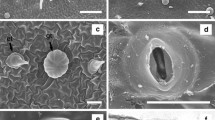Abstract
Differences in rhizogenesis between easy-to-root Forsythia×intermedia Zab. cv. Lynwood and difficult-to-root Syringa vulgaris L. cv. Madame Lemoine were measured in an experimental system based upon internodal stem sections excised from axillary shoot cultures. Root induction in Syringa was distinctly polar, responding best to distal application of indole-3-butyric acid (IBA), whereas Forsythia was equally responsive to IBA applied at either end. Root initiation in Syringa declined rapidly from 73% to 32% over 48 h when the application of a 24-h pulse of IBA was delayed following excision of the internode; in Forsythia a smaller decline (93–70%) occurred over 144 h. Forsythia internodes were the more responsive, and developed roots after distal or proximal application of 3 μM IBA, whereas Syringa required the distal application of 30 μM IBA.
Similar content being viewed by others

Author information
Authors and Affiliations
Additional information
Received: 22 March 2000 / Revision received: 5 June 2000 / Accepted: 5 June 2000
Rights and permissions
About this article
Cite this article
Marks, T., Simpson, S. Rhizogenesis in Forsythia×intermedia and Syringa vulgaris; application of a simple internode experimental system. Plant Cell Reports 19, 1171–1176 (2000). https://doi.org/10.1007/s002990000264
Issue Date:
DOI: https://doi.org/10.1007/s002990000264



